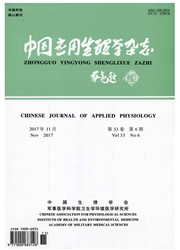

 中文摘要:
中文摘要:
目的:探讨下丘脑室旁核(PVN)内谷氨酸参与压力感受性反射中枢调节的神经化学机制。方法:在清醒大鼠,用脑部微量透析法和高效液相色谱法观察静脉注射苯肾上腺素诱发压力感受性反射对PVN区谷氨酸含量的影响;NMDA受体阻断剂MK-801或非NMDA受体阻断剂CNQX直接灌流PVN区并诱发压力感受性反射,进一步探讨PVN区谷氨酸对压力感受性反射的作用。结果:①静脉注射苯肾上腺素诱发压力感受性反射时,PVN内的谷氨酸含量迅速升高到注射前的384.82%±91.77%(P〈0.01)。②PVN区灌流谷氨酸受体阻断剂MK-801或CNQX,同时诱发压力感受性反射,其血压升值明显减少,心率降值明显增加(P〈0.01),压力感受性反射的敏感性(△HR/△MAP)明显增加(P〈0.01)。结论:PVN内的谷氨酸可能通过离子型谷氨酸受体参与压力感受性反射的中枢调节,而且此调节作用可能是抑制性的。
 英文摘要:
英文摘要:
Aim: To investigate the possible involvement of glutamate(Glu) in the paraventricular nucleus(PVN) in the central regulation of baroreflex. Methods: The baroreflex was induced by intravenous injection of phenylephrine in conscious rats, and the extracellular concentration of Glu in the PVN region was measured by microdialysis and high performance liquid chromatography (HPLC) techniques.To determine whether the observed Glu release was involved in the baroreflex, NMDA and non-NMDA receptor antagonists,MK-801 and CNQX, were perfused in the PVN region during baroreflex. Results: (1)During baroreflex, the Glu concentration in the PVN region immediatdy increased to 384.82 % -±91.77 % of basal level(P〈 0.01). (2)During baroreflex, direct perfusion of MK-801 and CNQX in the PVN were attenuated the increase of blood pressure and enhanced the decrease of FIR(P 〈 0.01), resulting a significant increase in baroreflex sensitivity(P 〈 0.01 ). Conclusion: Glutamate in PVN is involved in central regulation of baroreflex, which may inhibit baroreflex via ionothopic glutamate receptors.
 同期刊论文项目
同期刊论文项目
 同项目期刊论文
同项目期刊论文
 期刊信息
期刊信息
